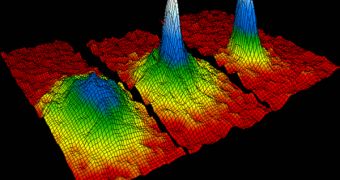A new class of quantum materials is hinted at theoretically by researchers at National Institute of Standards and Technology (NIST) Joint Quantum Institute (JQI) and the University of Maryland. They propose a new method of turning ultracold gas atoms into a supersolid, which is a state of matter that behaves very interestingly – it has all the properties of a solid body, and, at the same time, it is also friction-free, like the most advanced superfluid. Handling matter may be endowed with a whole new meaning, if the scientists behind this initiative manage to synthesize the material.
Supersolids, objects first theorized in 1970, have very intricate chemical properties and differ substantially from average objects people see around them every day. For one thing, all the atoms that make them up are arranged into regularly-repeating patterns, giving them strength. Another remarkable feature is the fact that particles flow frictionlessly around each other, and lose no energy in the process.
“If you add more clothing to a spinning washing machine, you increase the mass of its rim, and the machine needs to exert a greater force to make the wheel reverse direction. But in a supersolid washing machine, some of the clothes would mysteriously hover in space, staying stationary as the washer spins and making it easier for the wheel to reverse direction,” explains Ludwig Mathey, the lead author of the new investigation.
“Moreover, these hovering, frictionless clothes would form a predictable pattern – such as frictionless socks alternating with frictionless shirts – just as atoms arrange themselves in a repeating pattern in a crystal,” the he adds.
Researchers Ludwig Mathey, Ippei Danshita and Charles Clark, the ones who discovered the new method, will publish a paper in the journal Physical Review A, detailing the new technique, which features the premiere introduction of an optical lattice, a web of specialized light that keeps the atoms arranged beautifully.
If the process proves to be cost-effective and efficient, the world could see a class of quantum materials that would be very different from those in existence today. They would behave differently, feel differently, and have other properties as well. They could also open up new areas of research in the field of ultracold atom physics.

 14 DAY TRIAL //
14 DAY TRIAL //